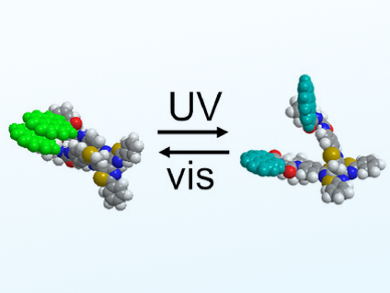Circularly polarized luminescence (CPL) is a phenomenon that shows different intensities of right and left circularly polarized light emission. The CPL technique could have applications in technologies such as anticounterfeiting labeling. High-speed switching and modulation of CPL could also be of use in cryptographic communication.
Takuya Nakashima, Tsuyoshi Kawai, and colleagues, Nara Institute of Science and Technology, Japan, have developed an efficient CPL photoswitching system that consists of photoresponsive supramolecular aggregates. The team uses a chiral photochromic tetrathiazole molecule with pyrene units (pictured). In a methylcyclohexane‐based mixed solvent system, these molecules self‐assemble into spherical nanoparticles with a helical tetrathiazole framework and two pyrene units bridged by amino acid spacers. The molecules show enhanced CPL activity.
The CPL activity can be modulated by light: A 6π-electrocyclization reaction in the tetrathiazole framework can be induced by UV light. The reaction changes the electronic structure of building units and efficiently quenches the emission, as well as the CPL, in the aggregate state. The energy-transfer-based quenching takes place in intra- and intermolecular fashions, resulting in more efficient CPL switching compared to the molecularly dispersed state of the same tetrathiazole framework.
- Dynamic Modulation of Circularly Polarized Luminescence in Photoresponsive Assemblies,
Yuichiro Hashimoto, Takuya Nakashima, Jumpei Kuno, Miku Yamada, Tsuyoshi Kawai,
ChemNanoMat 2018.
https://doi.org/10.1002/cnma.201800124

![Synthesis of [c2]Daisy Chains via Mechanochemistry](https://www.chemistryviews.org/wp-content/uploads/2025/04/202504_RotaxanesWithSolidStateMechanochemistry-125x94.png)

